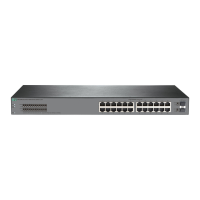253
Different VLAN ranges cannot overlap. Any of the original VLANs cannot be the same as the
translated VLAN.
uni single vlan-id-list translated-vlan vlan-id: Specifies the original VLANs and
the translated VLAN for a many-to-one VLAN mapping on the customer-side port. The
vlan-id-list argument specifies a space-separated list of up to 10 VLAN IDs, each of which is in
the range of 1 to 4094. The value range for the
vlan-id argument is 1 to 4094. Any of the original
VLANs cannot be the same as the translated VLAN.
nni: Configures the network-side port to use the original VLAN tags of the many-to-one mapping to
replace the VLAN tags of the packets destined for the user network.
nest range vlan-range-list nested-vlan vlan-id: Specifies the CVLAN ranges and
the SVLAN for a one-to-two VLAN mapping. The
vlan-range-list argument specifies a
space-separated list of up to 10 CVLAN items. Each item specifies a CVLAN ID or a range of CVLAN
IDs in the format of
vlan-id1 to vlan-id2. The value range for CVLAN IDs is 1 to 4094. The
value for the
vlan-id2 argument must be greater than the value for the vlan-id1 argument.
Different CVLAN ranges cannot overlap. The
vlan-id argument specifies the SVLAN ID in the
range of 1 to 4094.
nest single vlan-id-list nested-vlan vlan-id: Specifies the CVLANs and the SVLAN
for a one-to-two VLAN mapping. The
vlan-id-list argument specifies a space-separated list of
up to 10 CVLAN IDs, each of which is in the range of 1 to 4094. The
vlan-id argument specifies
the SVLAN ID in the range of 1 to 4094.
tunnel outer-vlan-id inner-vlan-id translated-vlan outer-vlan-id
inner-vlan-id
: Specifies the original outer VLAN ID, original inner VLAN ID, translated outer
VLAN ID, and translated inner VLAN ID for a two-to-two VLAN mapping. The value ranges for the
outer-vlan-id argument and the inner-vlan-id argument are both 1 to 4094.
all: Deletes all VLAN mapping configurations from the interface.
Usage guidelines
VLAN mapping takes effect only on VLAN-tagged packets received on an interface.
The original and translated VLANs in VLAN mappings on an interface must meet the following
requirements:
• Different types of VLAN mapping entries cannot include the same original VLANs or translated
VLANs.
• Different one-to-one or two-to-two VLAN mapping entries cannot include the same translated
VLANs. If you configure multiple one-to-one or two-to-two VLAN mapping entries for the same
original VLANs, the most recent configuration takes effect.
When you configure many-to-one VLAN mappings, following these restrictions and guidelines:
• For many-to-one VLAN mapping to take effect, configure many-to-one VLAN mapping in pairs
on both the customer side and the network side.
• An interface cannot be configured as the customer-side port and network-side port of
many-to-one VLAN mapping at the same time.
• After you configure an interface as the network-side interface of many-to-one VLAN mapping,
do not configure the other types of VLAN mapping on the interface.
The configuration restrictions between QinQ and VLAN mappings are as follows:
• Before you enable or disable QinQ on a port, you must remove all VLAN mappings on the port.
• You cannot configure two-to-two VLAN mappings on a QinQ-enabled port.
If you use both transparent VLANs and VLAN mappings on an interface, the transparent VLANs
cannot be the following VLANs:
• Original or translated VLANs of one-to-one, many-to-one, and one-to-two VLAN mappings.
• Original or translated outer VLANs of two-to-two VLAN mappings.

